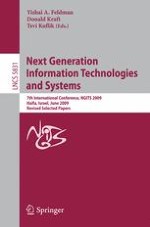Information technology is a rapidly changing field in which researchers and devel- ers must continuously set their vision on the next generation of technologies and the systems that they enable. The Next Generation Information Technologies and Systems (NGITS) series of conferences provides a forum for presenting and discussing the latest advances in information technology. NGITS conferences are international events held in Israel; previous conferences have taken place in 1993, 1995, 1997, 1999, 2002, and 2006. In addition to 14 reviewed papers, the conference featured two keynote lectures and an invited talk by notable experts. The selected papers may be classified roughly in five broad areas: • Middleware and Integration • Modeling • Healthcare/Biomedical • Service and Information Management • Applications NGITS 2009 also included a demonstration session and an industrial track focusing on how to make software development more efficient by cutting expenses with techn- ogy and infrastructures. This event is the culmination of efforts by many talented and dedicated individuals.
